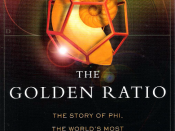The golden ratio is approximately 1.6. The mysteriously aesthetically pleasing ratio is the relation "a+b is to a as a is to b" or a+b/b=a/b=ÃÂ. It is denoted as the Greek letter àor æ (lower case, upper case respectively, upper case most often used as reciprocal). The letter is pronounced "phi". The golden ratio is found prominently in art, nature, and architecture. Throughout the centuries countless mathematicians have spent countless hours with the golden ratio and all its applications. It can be found in the great pyramid of Giza, the Parthenon and the Mona Lisa. It is prominent in human and animal anatomy, it can be found in the structure of plants, and even the DNA molecule exemplifies the ratio 1.6. The golden ratio also has applications in other mathematical equations such as logarithmic spirals and the Fibonacci numbers.
Before we can begin to discuss the application of the golden ratio we must examine how we translate "a+b is to a as a is to b" into the real, usable number 1.6.
Phi is an irrational number, so it's impossible to calculate exactly, but we can calculate a close approximation. As previously stated, the basic equation for phi is a+b/a=a/b=ÃÂ. So if a/b=ÃÂ, then a=bÃÂ. Now returning to our previous equation, a+b/a=ÃÂ, we can substitute a for bÃÂ. After substituting we have bÃÂ+b/bÃÂ=bÃÂ/b. Dividing out by b gives us ÃÂ+1/ÃÂ=ÃÂ. Rearranging yields the quadratic equation ÃÂ2-ÃÂ-1=0. Therefore via previous knowledge of the general form of a quadratic equation (ax2+bx+c=0) we can extrapolate the following values for our phi equation: a=1, b=-1, c=-1. Substitute these numbers in the quadratic function: x=[-b+/-âÂÂ(b2-4ac)]/2a and you get ÃÂ=[1+/-âÂÂ5]/2. This allows us to find the roots of the equation; ÃÂ=1.618 033 989 (commonly stated 1.6) and ÃÂ=-0.618 033...


